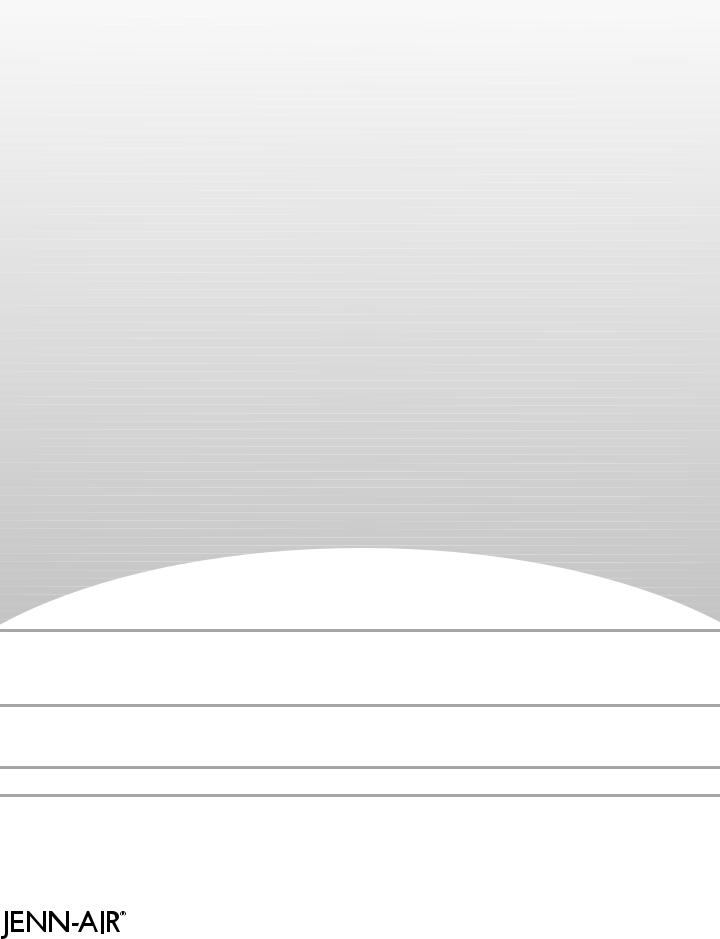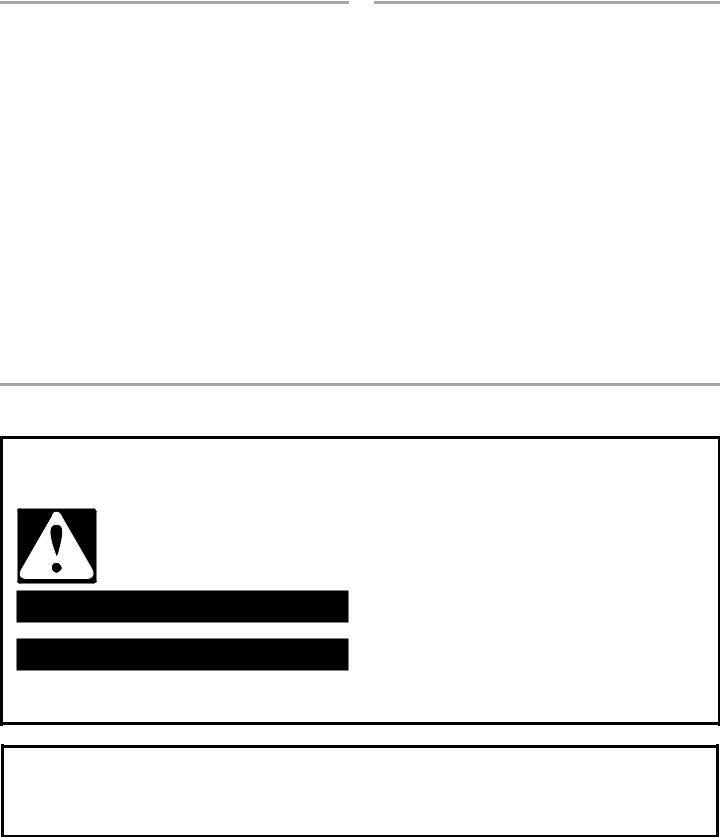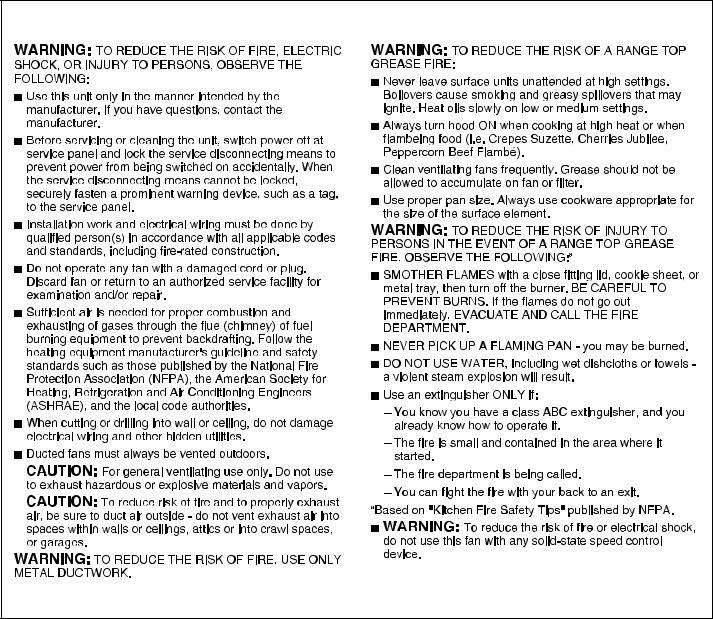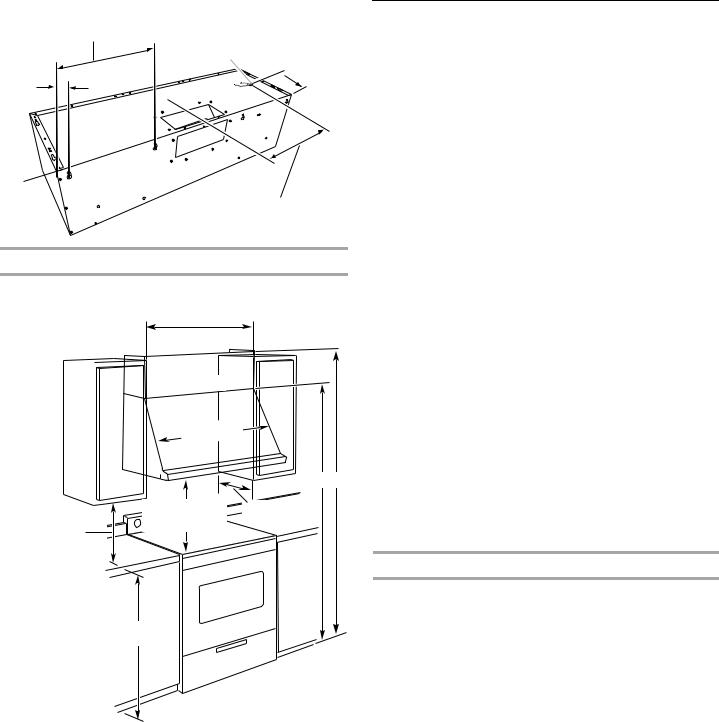Jenn-Air JXU9136WP1, JXU9136WP0, JXU9130WP1, JXU9130WP0 Owner’s Manual

JENN-AIR® 30" AND 36" (76.2 CM AND 91.4 CM) COMMERCIAL STYLE WALL-MOUNT
CANOPY RANGE HOOD
HOTTE DE CUISINIÈRE JENN-AIR® POUR MONTAGE MURAL DE STYLE COMMERCIAL 30" ET 36" (76,2 CM ET 91,4 CM)
Installation Instructions and Use & Care Guide
For questions about features, operation/performance, parts, accessories, or service in the U.S.A., call:
1-800-JENNAIR (1-800-536-6247) or visit our website at www.jennair.com.
In Canada, call: 1-800-JENNAIR (1-800-536-6247), or visit our website at www.jennair.ca.
Instructions d’installation et Guide d’utilisation et d’entretien
Au Canada, pour assistance, installation ou service, composez le 1-800-JENNAIR (1-800-536-6247) ou visitez notre site web à |
|
www.jennair.ca. |
|
Table of Contents/Table des matières ............ |
2 |
IMPORTANT: READ AND SAVE THESE INSTRUCTIONS.
FOR RESIDENTIAL USE ONLY.
IMPORTANT : LIRE ET CONSERVER CES INSTRUCTIONS.
POUR UTILISATION RÉSIDENTIELLE UNIQUEMENT.
LI3V3B/W10274318B

TABLE OF CONTENTS |
|
RANGE HOOD SAFETY ................................................................. |
2 |
INSTALLATION REQUIREMENTS ................................................ |
4 |
Tools and Parts ............................................................................ |
4 |
Location Requirements................................................................ |
4 |
Venting Requirements.................................................................. |
5 |
Electrical Requirements ............................................................... |
6 |
INSTALLATION INSTRUCTIONS .................................................. |
7 |
Prepare Location.......................................................................... |
7 |
Install Range Hood....................................................................... |
9 |
Make Electrical Connection ......................................................... |
9 |
Install Vent Covers (Optional)..................................................... |
10 |
Complete Installation ................................................................. |
10 |
RANGE HOOD USE...................................................................... |
10 |
Range Hood Controls ................................................................ |
10 |
RANGE HOOD CARE ................................................................... |
11 |
Cleaning...................................................................................... |
11 |
WIRING DIAGRAM ...................................................................... |
12 |
ASSISTANCE OR SERVICE......................................................... |
13 |
In the U.S.A. ............................................................................... |
13 |
In Canada ................................................................................... |
13 |
Accessories................................................................................ |
13 |
WARRANTY .................................................................................. |
14 |
TABLE DES MATIÈRES |
|
SÉCURITÉ DE LA HOTTE DE CUISINIÈRE................................ |
15 |
EXIGENCES D'INSTALLATION................................................... |
17 |
Outils et pièces........................................................................... |
17 |
Exigences d’emplacement......................................................... |
17 |
Exigences concernant l’évacuation ........................................... |
18 |
Spécifications électriques .......................................................... |
20 |
INSTRUCTIONS D'INSTALLATION............................................. |
20 |
Préparation de l'emplacement................................................... |
20 |
Installation de la hotte ................................................................ |
22 |
Raccordement électrique........................................................... |
23 |
Installation des cache-conduits (facultatif) ................................ |
24 |
Achever l’installation .................................................................. |
24 |
UTILISATION DE LA HOTTE ....................................................... |
24 |
Commandes de la hotte de cuisinière ....................................... |
24 |
ENTRETIEN DE LA HOTTE.......................................................... |
25 |
Nettoyage ................................................................................... |
25 |
SCHÉMA DE CÂBLAGE .............................................................. |
26 |
ASSISTANCE OU SERVICE......................................................... |
27 |
Au Canada.................................................................................. |
27 |
Accessoires ................................................................................ |
27 |
GARANTIE..................................................................................... |
28 |
RANGE HOOD SAFETY
Your safety and the safety of others are very important.
We have provided many important safety messages in this manual and on your appliance. Always read and obey all safety messages.
This is the safety alert symbol.
This symbol alerts you to potential hazards that can kill or hurt you and others.
All safety messages will follow the safety alert symbol and either the word “DANGER” or “WARNING.” These words mean:
 DANGER
DANGER
 WARNING
WARNING
You can be killed or seriously injured if you don't immediately follow instructions.
You can be killed or seriously injured if you don't follow instructions.
All safety messages will tell you what the potential hazard is, tell you how to reduce the chance of injury, and tell you what can happen if the instructions are not followed.
State of California Proposition 65 Warnings:
WARNING: This product contains one or more chemicals known to the State of California to cause cancer.
WARNING: This product contains one or more chemicals known to the State of California to cause birth defects or other reproductive harm.
2

IMPORTANT SAFETY INSTRUCTIONS |
READ AND SAVE THESE INSTRUCTIONS |
3

INSTALLATION REQUIREMENTS
Tools and Parts
Gather the required tools and parts before starting installation. Read and follow the instructions provided with any tools listed here.
Tools needed
■Level
■Drill with 1¼" (3.0 cm), ³⁄" (4.8 mm), ¹⁄" (3.0 mm), and ⁄" (7.9 mm) drill bits
■Pencil
■Wire stripper or utility knife
■Tape measure or ruler
■Pliers
■Caulking gun and weatherproof caulking compound
■Vent clamps
■Jigsaw or keyhole saw
■Flat-blade screwdriver
■Metal snips
■Phillips screwdriver
■Metric hex key set
Parts needed
■Home power supply cable
■½" (12.7 mm) UL listed or CSA approved strain relief
■3 UL listed wire connectors
■1 wall or roof cap
■Metal vent system
Parts supplied
Remove parts from packages. Check that all parts are included.
■Hood canopy assembly with ventilator and light bulbs installed
■3¼" x 10" (8.3 x 25.4 cm) rectangular vent connector
■2 metal grease filters for 30" (76.2 cm) model
■3 metal grease filters for 36" (91.4 cm) model
■T20® Torx®† adapter
■4 - 5 x 45 mm mounting screws
■6 - 4.5 x 13 mm screws
■3 - 4 x 8 mm screws
■4 - 10 x 50 wall anchors
Location Requirements
IMPORTANT: Observe all governing codes and ordinances.
Have a qualified technician install the range hood. It is the installer's responsibility to comply with installation clearances specified on the model/serial/rating plate. The model/serial/rating plate is located behind the left filter on the rear wall of the vent hood.
Canopy hood location should be away from strong draft areas, such as windows, doors and strong heating vents.
Cabinet opening dimensions that are shown must be used. Given dimensions provide minimum clearance.
Grounded electrical outlet is required. See “Electrical Requirements” section.
The canopy hood is factory set for venting through the roof or wall.
All openings in ceiling and wall where canopy hood will be installed must be sealed.
For Mobile Home Installations
The installation of this range hood must conform to the Manufactured Home Construction Safety Standards, Title 24 CFR, Part 328 (formerly the Federal Standard for Mobile Home Construction and Safety, Title 24, HUD, Part 280) or when such standard is not applicable, the standard for Manufactured Home Installation 1982 (Manufactured Home Sites, Communities and Setups) ANSI A225.1/NFPA 501A, or latest edition, or with local codes.
Product Dimensions
Front View
2⁄"
³⁄" (6.5 cm) (1.0 cm) 
7½" (19.0 cm)
29¹⁄" (74.0 cm): 30" (76.2 cm) models
35¹⁄" (89.2 cm): 36" (91.4 cm) models
 12"
12"  (30.5 cm)
(30.5 cm)
10" (25.4 cm)
2"  (5.1 cm)
(5.1 cm)
23" (58.4 cm)
30" (76.2 cm) 36" (91.4 cm)
†®TORX and T20 are registered trademarks of Acument Intellectual Properties, LLC.
4

Back View
8¹⁄" (20.6 cm): 30" (76.2 cm) models 11" (27.9 cm): 36" (91.4 cm) models
Wiring knockout
7⁄"
 (20.0 cm)
(20.0 cm)
1⁄"
(3.2 cm)
¾"
(1.9 cm)
12³⁄" (31.0 cm): 30" (76.2 cm) models 12¹⁄" (30.8 cm): 36" (91.4 cm) models
Cabinet Dimensions
30" (76.2 cm) or 36" (91.4 cm) cabinet opening width
(If installed between cabinets)
|
Duct |
cover |
(if used) |
|
|
|
|
||
|
|
|
|
|
|
|
Min. cabinet |
|
|
|
|
openingwidth |
||
|
Canopy |
|
||
|
|
|
|
A B |
|
|
X |
|
13" (33.0 cm) |
|
Bottom of canopy |
|||
|
|
|||
18" (45.7 cm) min. |
to cooking surface |
|
||
|
|
|
|
|
clearance upper |
|
|
|
|
cabinet to countertop |
|
|
|
|
36" (91.4 cm) countertop height
A. 76" (193.0 cm) minimum for |
B. 88" (223.5 cm) minimum for |
installations with canopy only. |
installations with optional |
|
duct cover. |
IMPORTANT:
Minimum distance “X”: 30" (76.2 cm)
Suggested maximum distance “X”: 36" (91.4 cm)
Venting Requirements
■Vent system must terminate to the outdoors.
■Do not terminate the vent system in an attic or other enclosed area.
■Do not use a 4" (10.2 cm) laundry-type wall cap.
■Use metal vent only. Rigid metal vent is recommended.
■The length of vent system and number of elbows should be kept to a minimum to provide efficient performance.
For the most efficient and quiet operation:
■Use no more than three 90° elbows.
■Make sure there is a minimum of 24" (61.0 cm) of straight vent between the elbows if more than 1 elbow is used.
■Do not install 2 elbows together.
■Use clamps to seal all joints in the vent system.
■The vent system must have a damper. If roof or wall cap has a damper, do not use damper supplied with the range hood.
■Use caulking to seal exterior wall or roof opening around the cap.
■The size of the vent should be uniform.
Cold Weather Installations
An additional back draft damper should be installed to minimize backward cold air flow and a thermal break should be installed to minimize conduction of outside temperatures as part of the vent system. The damper should be on the cold air side of the thermal break.
The break should be as close as possible to where the vent system enters the heated portion of the house.
Makeup Air
Local building codes may require the use of makeup air systems when using ventilation systems greater than specified CFM of air movement. The specified CFM varies from locale to locale. Consult your HVAC professional for specific requirements in your area.
Venting Methods
This canopy hood is factory set for venting through the roof or wall.
A 3¹⁄ " x 10" (8.3 x 25.4 cm) rectangular vent system is needed for installation (not included). The hood exhaust opening is 3¹⁄ " x 10" (8.3 x 25.4 cm). Vent system can terminate either through the roof or wall. To vent out of the top of the range hood and through a wall, a 90° elbow is needed. See “Install Range Hood” section for details for installing the damper.
NOTE: Flexible vent is not recommended. Flexible vent creates back pressure and air turbulence that greatly reduce performance.
5
